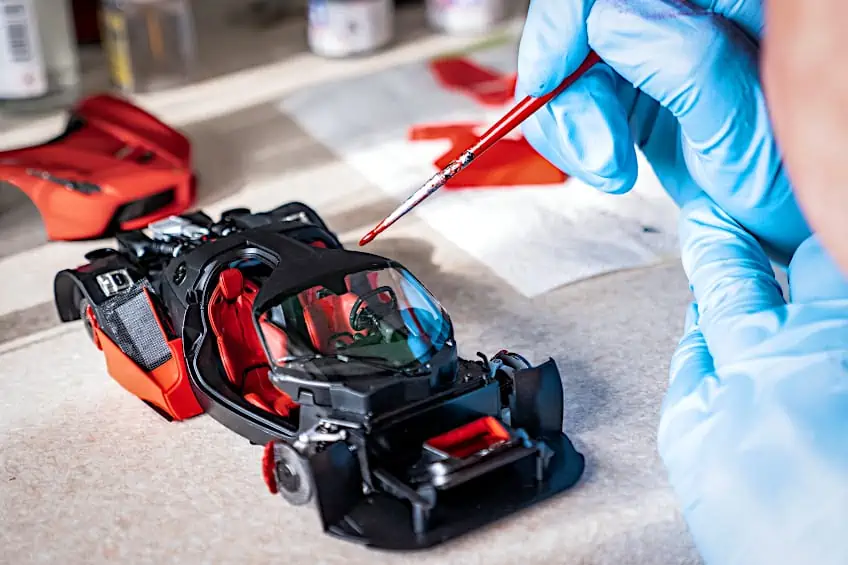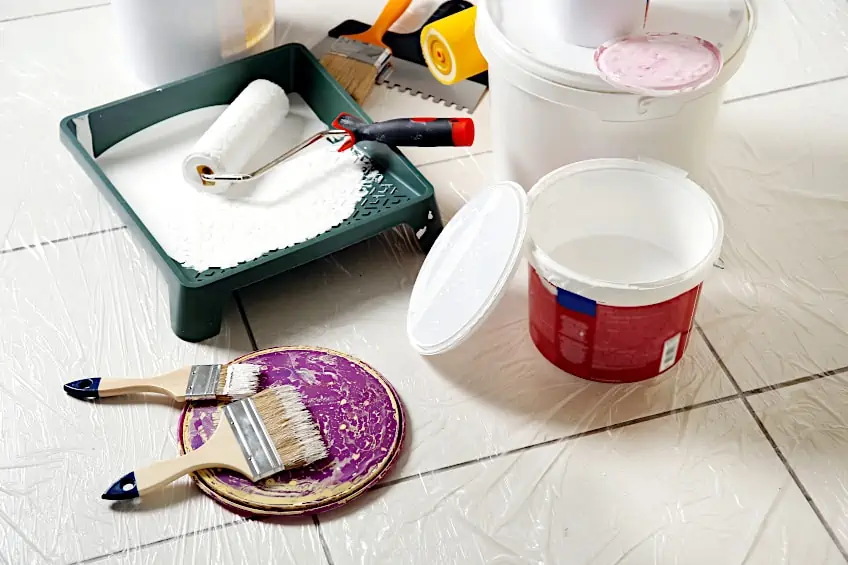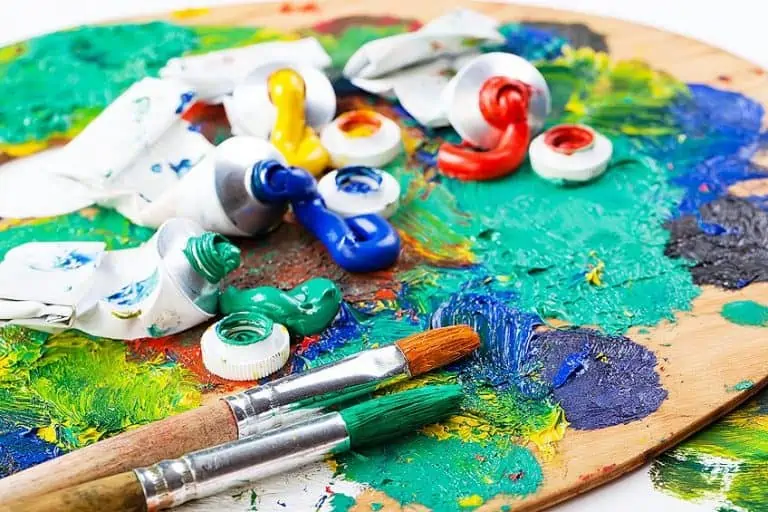Does Acrylic Paint Work on Plastic? – Your Guide to Painting Plastics
This post may contain affiliate links. We may earn a small commission from purchases made through them, at no additional cost to you.
Almost every day, we see and use plastics. If you are working with acrylic paints, you may want to experiment with painting acrylic on plastic items. However, because of the smoothness of the plastic surface, you may be concerned about whether the acrylic paint will work on it. So, you are probably asking yourself: “Does acrylic paint work on plastic?” In this article, we will cover all you need to know about acrylic painting on plastic, including how to use acrylic paints on plastics and the tips for acrylic painting on plastics.
Table of Contents
- 1 Does Acrylic Paint Work on Plastic?
- 2 A Guide to Painting Plastic With Acrylic Paint
- 3 How to Seal Acrylic Paint on Plastic
- 4 Tips for Painting Plastic With Acrylic Paint
- 5 Frequently Asked Questions
- 5.1 Does Acrylic Paint Stay on Plastic?
- 5.2 Is It Necessary to Prepare Plastic Before Painting?
- 5.3 Do I Have to Use a Sealant?
- 5.4 How to Maintain Acrylic Paint on Plastic?
- 5.5 What Is a Good Primer for Plastic?
- 5.6 What Is the Best Way to Prepare Plastic for Painting?
- 5.7 How Do You Keep Acrylic Paint From Cracking on Plastic?
- 5.8 Will Acrylic Paint Stick to Plastic?
Does Acrylic Paint Work on Plastic?
Acrylic paint is a great medium that has several benefits over other media. It has vibrant colors as well as a thick consistency that makes it easy to apply to the surfaces on which it is intended for usage. So, does acrylic paint work on plastic?

Acrylic paint works on most types of plastics. You must, however, carefully prepare and get the right tools to ensure you make your acrylic paint stick to the surfaces. You will also need to be sure that the type of paint you choose for your projects is appropriate for the job. When acrylic paint is applied to a plastic surface using the appropriate paint for that surface, the paint will dry into plastic and can last a very long time. Several factors can also affect the way that acrylic adheres to plastic.

The steps that you take when using acrylic paint for plastic will vary based on the kind of task you are doing. You must take into account the size of the plastic surface, the tools required, as well as the amount of time required to complete your project.

To get the best results with acrylic paint on plastic, look for one that has been designed with the surface in mind. A large number of acrylic craft paints are not suited for use with plastic objects. If you are working on a large surface area, acrylic spray paints are a great choice. On the other hand, if you are working on small areas, bottled acrylic paints or those in tubes are suitable for small projects.

A Guide to Painting Plastic With Acrylic Paint
Because of the smooth and non-porous nature of plastic surfaces, painting on such a surface becomes difficult. Therefore, preparing the surface is essential before you start applying acrylic paint. To paint plastic surfaces, a base coat, also commonly referred to as a primer, is required. This coat is specially prepared to be used on plastic surfaces before the actual painting process. Finally, after painting plastic with acrylic paint, you may want to seal it with a clear sealer to finish the procedure, although this is not always necessary depending on the surface you are painting.
Step 1: Get the Materials
Preparation is essential before beginning any acrylic painting on plastic project. This involves ensuring that you have all of the required supplies, such as a protective suit and gloves, as well as paint and paintbrushes. You should also make certain that you are in an adequately ventilated environment.

Step 2: Prepare the Plastic Surface
The whole plastic surface needs to be thoroughly cleaned. You can use mild detergent soap and warm water. A grease or mold remover may be used to get rid of any leftover dirt, filth, or grease if it is essential. You should also thoroughly rinse the plastic with clean water before drying it with a soft towel.

You may also use rubbing alcohol to clean the plastic surface, which will assist you in getting rid of any oil or grime. After you’ve removed all of the debris from the surface, you should smooth it out using fine-grit sandpaper. When using fine-grit sandpaper, be careful not to rub too hard on the surface, since this might cause the surface to get scratched and damaged. Once the sanding is completed, wipe the plastic surface with a clean towel once more.

Step 3: Add Primer
A primer helps in ensuring that the acrylic paint adheres to the plastic surface easily. For the greatest results, go for a primer that is made for use on plastic. Many types are available as spray primers, but there are also liquid primers available in bottles or cans. The primer should be applied following the instructions provided on the bottle. Remember to cover the whole area in thin, equal layers to provide a professional finish. Let the primer dry before continuing.

Step 4: Apply Paint to the Surface
Demarcate the parts you do not want to paint using painter’s tape first, then proceed to paint the rest of the surface. When the surface has been cleaned properly and dried, apply the tape in the proper locations and attempt to lay the item flat. A paintbrush or sponge can be used if you would like to apply paint to the surface.

Avoid stacking acrylics on top of each other too thickly, since the layers may not adhere properly. You will be able to find a lot of acrylic paints on the market. You will also find acrylic paints that contain a primer.

Step 5: Apply a Sealant Over the Surface
Once you have successfully painted your surface, apply a sealant to protect it from any bumps or scratches. Furthermore, the sealant finishes off the painting job. Several kinds of acrylic paints are available. Make sure to choose a sealant that works best for plastic surfaces.

Step 6: Allow the Surface to Dry
Finally, let your plastic surface dry for at least two hours. The drying time will also vary depending on the kind of paint you are using. For instance, some brands have a drying time of up to 12 hours.
Using Acrylic Spray Paint on Plastic
Acrylic painting on plastic will be quite simple and quick if you use acrylic spray paint, which is what we recommend for beginners. Some spray paints do not require you to use a primer or a sealer as they are already included in the paint. The following are the procedures that must be completed to use spray paint on plastic.

Step 1: Prepare the Surface
Before you begin spraying the surfaces, you must first ensure that the surfaces are clean. Utilizing mild detergent soapy water, you may thoroughly clean the whole plastic surface. Make sure that all the dirt, grime, and residues have been removed.
Step 2: Prime the Surface
If you are using standard spray paint, such as those that are not intended for use on plastic materials, priming the surface is necessary before painting. There are a variety of primers commercially available that are designed specifically for use on plastic surfaces. Once the primer has been applied, let it dry completely before painting.
The primer doesn’t need to have the same color as the paint for it to work. If, on the other hand, you manage to come across a primer that is the same color as the paint, you can use it. Consequently, while picking a primer, exercise caution since you may wind up selecting a primer that is darker than the color you are painting. It is generally recommended that you use a clear primer.

Step 3: Spray the Paint on the Surface
Start by testing the paint on a piece of paper, fabric, or cardboard before you begin spraying the paint on the surface. This helps in ensuring that the color and consistency are exactly what you are looking for before proceeding. To spray the surface, position the nozzle towards the surface and begin spraying lightly.
When spraying, the can must be between 8 to12 inches away from the surfaces being sprayed. You may need to apply many coats of paint to achieve what you are looking for. Make sure the first coat dries completely before adding the second layer. If the surface is still not completely coated after two hours of drying, consider applying a third and final layer of paint.

Step 4: Allow the Surface to Dry
Once you have finished spraying the paint on the plastic surface, it is time to let it dry. Be sure to leave the surface untouched for at least two hours. This ensures that the surface completely dries without any problems.
How to Seal Acrylic Paint on Plastic
Because plastic products are regularly used, it is important to ensure that the acrylic paint used to paint their surfaces will last for an extended period. But will acrylic paint stick to plastic? The use of a sealer is an excellent way to ensure that the paint lasts for a long period. A sealer is necessary because it aids in adding a waterproof aspect to the acrylic paint, which helps to keep it from being damaged by rain or moisture.

Paint sealers are available in both liquid and spray forms. Additionally, a spray sealer product comes with a variety of finishes to pick from, including glossy and matte options. There are also many different brands from which to choose. When selecting a sealer, you must make sure that the sealer is compatible with acrylic paints and is suitable for plastic materials. It should also be able to offer you a clear coat that will aid in the preservation of the color of the plastic surfaces you are working with.
The sealer must only be applied once the paint has been allowed to dry fully. Liquid sealers that must be applied with a brush sometimes need two coats, but a single application of spray sealer is generally sufficient. You may wish to add an additional layer of protection to outdoor plastic objects.
Tips for Painting Plastic With Acrylic Paint
When painting with acrylics, there are several things that you need to keep in mind. There are a few tips and tricks that you should keep in mind to ensure that your item comes out nicely every time after it has been painted.
Clean Lines May Be Achieved Using Tape
Painter’s tape is useful for creating neat lines or keeping paint away from places that you do not want to get paint on. Although a premium brand may be more expensive, a good-quality tape will also offer the greatest outcomes. If you are not cautious, cheap painter’s tape might result in jagged lines.

Remove the Tape
The tape on the paint surfaces needs to be removed as soon as possible. You must not wait for the paint to completely dry before you can remove the tape. Otherwise, the tape may cause your freshly painted surface to rip away. Be sure to use care while removing the tape so that you do not scratch up your freshly painted surface.
Consider Sandpaper Substitutes
On plastic, you might use a liquid sander rather than typical sandpaper to smooth out the surface. These supplies may be purchased at any local hardware store. Using liquid a sander will save time on preparatory work since they will clean as well as remove the glossy surface of the plastic at the same time. Many crafters also swear by scouring pads for creating texture on plastic.

Consider Using Primer Substitutes
If you are unable to find primer, oil-based paint and enamel paint can be used as substitutes. You may paint these as the basecoat on the plastic to prepare it for painting with acrylic paint. However, a primer designed specifically for plastic remains the most effective alternative.
Acrylic paint is one of the greatest materials for painting or renewing plastic surfaces since it dries quickly. Acrylic paints may be used to decorate a wide variety of plastic goods, making them an excellent alternative for any projects involving painting. We hope that this article has addressed your concern of whether acrylic paint can be used on plastic, as well as provided you with a thorough understanding of the fundamentals of painting on acrylic.
Frequently Asked Questions
Does Acrylic Paint Stay on Plastic?
Acrylic paint works best on canvas, wood, or ceramic than on other surfaces. Acrylic paint can also stay on plastic surfaces as long as the application has been properly done. When using acrylic paint on plastic surfaces, appropriate sealers must be used to make the paint last for a long time. Acrylic paint on plastic surfaces may be improved with the use of sealers and base coats, which can be applied before the paint is applied.
Is It Necessary to Prepare Plastic Before Painting?
Sanding will assist in smoothing the surface and removing imperfections from the surface of the plastic, allowing for the greatest finish to be achieved. Sanding also contributes to the creation of a larger surface area, which aids in the improvement of paint adherence.
Do I Have to Use a Sealant?
There is no definitive rule that says you must put a sealer on your item, although it is highly recommended. Doing so will protect your paint against chips and scratches that may occur as a result of continuous usage, as well as from the elements. A sealant is a smart choice for items such as children’s toys, toy bins, and food containers that need to be very durable to function properly.
How to Maintain Acrylic Paint on Plastic?
When applied to a freshly painted plastic surface, a clear acrylic sealer provides an additional layer of protection that makes the surface extremely resistant to harm. Although you do not need to use a sealer, doing so may increase the product’s durability, which is especially crucial if you are painting an outdoor item. There are spray sealers available for purchase to make the process more convenient.
What Is a Good Primer for Plastic?
A good primer for plastic is one that will ensure that the acrylic paint adheres to the surface easily. It also has other great features including great consistency and durability among others. Primers are available in a range of formulations on the market. You can get good primers from a variety of manufacturers, including Krylon, Rustoleum, and Sunnyside, among others.
What Is the Best Way to Prepare Plastic for Painting?
First and foremost, you must thoroughly clean the plastic surface with mild soap and lukewarm water. As soon as the plastic surface has dried, wash it off with rubbing alcohol before wiping it down again with a clean towel.
How Do You Keep Acrylic Paint From Cracking on Plastic?
You may use a good pouring medium to help prevent your acrylic paint for plastic from getting damaged once it has dried completely. Be sure to avoid using low-cost pouring mediums since they might easily cause discoloring on your surfaces.
Will Acrylic Paint Stick to Plastic?
Acrylic paint will not easily adhere to a plastic surface unless it has been properly prepped and sprayed with a primer before using the paint on it. Because of the smoothness of the plastic surfaces, the paint will not easily attach to the plastic. It is for this reason that you must roughen up the surface a bit to give the paint a good grip.








